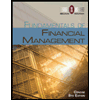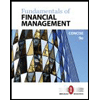
1.
Concept Introduction:
Earnings per Share: Earnings per share (EPS) is calculated by dividing a company's net profit by the total number of outstanding common shares. EPS is a popular statistic for determining corporate value, and it shows how much money a firm produces for each share of its stock.
The basic earnings per share.
2.
Concept Introduction:
Dividend Yield: Dividend yield illustrates how much a corporation pays out in dividends annually in relation to the price of its stock.
The dividend yield.
3.
Concept Introduction:
Price-earnings ratio: The relationship between a company's stock price and earnings per share is shown by calculating the price-earnings ratio. The market price per share must be divided by the EPS in order to derive the price-earnings ratio.
The Price Earnings ratio.
4)
Introduction: The relationship between a company's stock price and earnings per share is shown by calculating the price-earnings ratio. The market price per share must be divided by the EPS in order to derive the price-earnings ratio
Based on PE Ratio, Company having greater expectations about future performance.
Want to see the full answer?
Check out a sample textbook solution
Chapter 11 Solutions
FINAN&MANAGERIAL ACCT (LL)W/1TERM ACCESS
- I am trying to find the accurate solution to this financial accounting problem with appropriate explanations.arrow_forwardPlease provide the answer to this general accounting question using the right approach.arrow_forwardI need assistance with this general accounting question using appropriate principles.arrow_forward
- Can you solve this general accounting problem using appropriate accounting principles?arrow_forwardI need help solving this general accounting question with the proper methodology.arrow_forwardHenderson Corporation uses the calendar year as its tax year. It acquires and places into service two depreciable assets during 2024: • Asset #1: 7-year property; $940,000 cost; placed into service on January 20. Asset #2: 5-year property; $410,000 cost; placed into service on August 1. View the MACRS half-year convention rates. Read the requirements. Calculate Henderson's depreciation deductions for 2024. (Use MACRS rates to two decimal places, X.XX%. Round the MACRS depreciation to the nearest dollar.) 2024 Depreciation Asset #1 Asset #2 Total depreciation 134,326 82,000 216,326 Calculate Henderson's depreciation deductions for 2025. (Use MACRS rates to two decimal places, X.XX%. Round the MACRS depreciation to the nearest dollar.) 2025 Depreciation Asset #1 Asset #2 Total depreciation 230,206 131,200 361,406 b. What are Henderson's depreciation deductions for 2024 and 2025 if this is the only property it places into service in those years and Henderson elects Sec. 179 expensing for…arrow_forward
- Please explain the solution to this general accounting problem with accurate principles.arrow_forwardHenderson Corporation uses the calendar year as its tax year. It acquires and places into service two depreciable assets during 2024: • Asset #1: 7-year property; $940,000 cost; placed into service on January 20. Asset #2: 5-year property; $410,000 cost; placed into service on August 1. View the MACRS half-year convention rates. Read the requirements. Calculate Henderson's depreciation deductions for 2024. (Use MACRS rates to two decimal places, X.XX%. Round the MACRS depreciation to the nearest dollar.) 2024 Depreciation Asset #1 Asset #2 Total depreciation 134,326 82,000 216,326 Calculate Henderson's depreciation deductions for 2025. (Use MACRS rates to two decimal places, X.XX%. Round the MACRS depreciation to the nearest dollar.) 2025 Depreciation Asset #1 Asset #2 Total depreciation 230,206 131,200 361,406 b. What are Henderson's depreciation deductions for 2024 and 2025 if this is the only property it places into service in those years and Henderson elects Sec. 179 expensing for…arrow_forwardCarlyon Company listed the following items in its December 31, Year 1, financial statements: Investment in Man Company bonds $21,000 Dividends payable: preferred 4,000 Dividends payable: common 50,000 Preferred stock, 8%, $100 par 100,000 Common stock, $10 par 500,000 Additional paid-in capital on preferred stock 20,000 Additional paid-in capital on common stock 262,500 Retained earnings 270,000 During Year 2, the following transactions occurred: Feb. 2 Paid the semiannual dividends declared on December 15, Year 1. Mar. 5 Declared a property dividend, payable to common shareholders on April 5 in Man Company bonds being held to maturity. The bonds (which have a book value of $21,000) have a current market value of $30,000. Apr. 5 Paid the property dividend. Jul. 6 Declared a $4 per share semiannual cash dividend on preferred stock and a $1.10 per share semiannual dividend on common stock, to be paid on August 17. Aug. 17 Paid the cash dividends.…arrow_forward
- Required information [The following information applies to the questions displayed below.] Jarvie loves to bike. In fact, he has always turned down better-paying jobs to work in bicycle shops where he gets an employee discount. At Jarvie's current shop, Bad Dog Cycles, each employee is allowed to purchase four bicycles a year at a discount. Bad Dog has an average gross profit percentage on bicycles of 25 percent. During the current year, Jarvie bought the following bikes: Description Retail Price Specialized road bike $ 4,000 Cost $ 3,600 Employee Price $ 2,800 Rocky Mountain mountain bike 5,000 4,100 4,000 Trek road bike 3,900 3,300 2,730 Yeti mountain bike 4,600 3,400 3,680 b. What amount of deductions is Bad Dog allowed to claim from these transactions? Amount of deductionsarrow_forwardJarvie loves to bike. In fact, he has always turned down better-paying jobs to work in bicycle shops where he gets an employee discount. At Jarvie's current shop, Bad Dog Cycles, each employee is allowed to purchase four bicycles a year at a discount. Bad Dog has an average gross profit percentage on bicycles of 25 percent. During the current year, Jarvie bought the following bikes: Description Retail Price Specialized road bike $ 4,000 Cost $ 3,600 Employee Price $ 2,800 Rocky Mountain mountain bike 5,000 4,100 4,000 Trek road bike 3,900 3,300 2,730 Yeti mountain bike 4,600 3,400 3,680 a. What amount is Jarvie required to include in taxable income from these purchases? Amount to be includedarrow_forwardYost received 300 NQOs (each option gives Yost the right to purchase 10 shares of Cutter Corporation stock for $19 per share). At the time he started working for Cutter Corporation three years ago, Cutter's stock price was $19 per share. Yost exercised all of his options when the share price was $38 per share. Two years after acquiring the shares, he sold them at $59 per share. Note: Input all amounts as positive values. Leave no answer blank. Enter zero if applicable. d. Assume that Yost's options were exercisable at $24 and expired after five years. If the stock only reached $22 during its high point during the five-year period, what are Yost's tax consequences on the grant date, the exercise date, and the date the shares are sold, assuming his ordinary marginal rate is 35 percent and his long-term capital gains rate is 15 percent? Grant date Exercise date Taxes Due Sale datearrow_forward

 EBK CONTEMPORARY FINANCIAL MANAGEMENTFinanceISBN:9781337514835Author:MOYERPublisher:CENGAGE LEARNING - CONSIGNMENT
EBK CONTEMPORARY FINANCIAL MANAGEMENTFinanceISBN:9781337514835Author:MOYERPublisher:CENGAGE LEARNING - CONSIGNMENT Fundamentals Of Financial Management, Concise Edi...FinanceISBN:9781337902571Author:Eugene F. Brigham, Joel F. HoustonPublisher:Cengage Learning
Fundamentals Of Financial Management, Concise Edi...FinanceISBN:9781337902571Author:Eugene F. Brigham, Joel F. HoustonPublisher:Cengage Learning Fundamentals of Financial Management, Concise Edi...FinanceISBN:9781285065137Author:Eugene F. Brigham, Joel F. HoustonPublisher:Cengage Learning
Fundamentals of Financial Management, Concise Edi...FinanceISBN:9781285065137Author:Eugene F. Brigham, Joel F. HoustonPublisher:Cengage Learning Fundamentals of Financial Management, Concise Edi...FinanceISBN:9781305635937Author:Eugene F. Brigham, Joel F. HoustonPublisher:Cengage Learning
Fundamentals of Financial Management, Concise Edi...FinanceISBN:9781305635937Author:Eugene F. Brigham, Joel F. HoustonPublisher:Cengage Learning Cornerstones of Financial AccountingAccountingISBN:9781337690881Author:Jay Rich, Jeff JonesPublisher:Cengage Learning
Cornerstones of Financial AccountingAccountingISBN:9781337690881Author:Jay Rich, Jeff JonesPublisher:Cengage Learning





